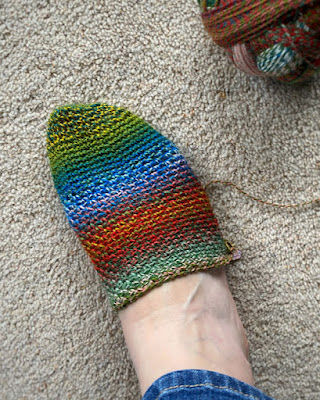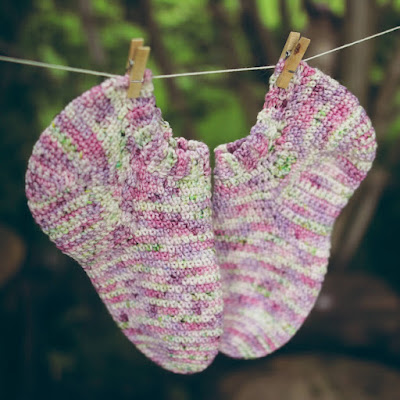Hello! Hands up if you have a yarn stash! I’m sure we all have one, don’t we? – that overflowing basket, bin, or even room filled with the beautiful remnants of past projects. While those little bits and bobs hold all sorts of memories, they can sometimes feel … overwhelming, can’t they? Today I'm going to show you ways in which your leftover yarn is actually a treasure trove waiting to be unlocked. I'm sharing six fun and creative ways to transform those odds and ends into something beautiful and useful. Are you ready to explore the wonderful world of scrap yarn projects with me?
1. The Joyful Jumble: Colourful Granny Squares
For me granny squares are the ultimate scrap yarn project! Their small size makes them perfect for using up even the tiniest amounts of yarn. Embrace the randomness and create squares in a riot of colours for a truly unique and cheerful blanket, cushion cover or even a quirky bag. Don't worry about colour matching – the more eclectic, the better! An added bonus is that granny squares are super portable for on-the-go crocheting.
Pro tip: Keep a dedicated bag or container for your usable scraps so they're easily accessible when the granny square mood strikes you. I even sort my scraps into different yarn thicknesses to make it easy to see what I have and when I have enough to start a new scrappy blanket project.
Marta Loves: Battenberg Blanket by Sandra Paul. Technically mine is in hibernation, due to my home circumstances and the huge size it has become, not because I don’t love it! I thoroughly recommend this pattern if you like a longterm project, find the pattern on Sandra's website here.
2. Stripes Galore: Creating Accessories with Character
Simple stripes can turn even the most clashy yarn leftovers into stylish accessories. Think vibrant scarves with unexpected colour pops, playful fingerless mitts with contrasting cuffs or colourful socks (my favourite!). The beauty of stripes with scrap yarn is the freedom to experiment with colour combinations you might not normally choose. Each stripe tells a little story of a past project!
Pro tip: Try rolling a D20! It's so easy, simply allocate your colours 1 through 20, then roll the die to let the number you roll decide which colour you’ll use.
Marta Loves: Jaywalk Socks by Deanne Ramsay. I made these using several started balls of yarn and used different scrap yarns for the heels, toes and cuffs. Find the pattern on Ravelry here.
3. Blooming Beauties: Crochet Flowers and Appliqués
Small amounts of yarn are ideal for creating gorgeous crochet flowers, leaves and other appliqués. These little motifs can be used to embellish larger projects, add a handmade touch to clothing or bags or even be strung together to create charming bunting or garlands. Let your creativity bloom and turn those tiny treasures into beautiful details.
Pro tip: Keep a collection of small flower and leaf patterns handy for when inspiration (and a small scrap of yarn) strikes.
Marta loves: A free crochet pattern of mine for a simple flower using a teenie scrap of yarn in whichever thickness/ fibre you have to hand. You can find the whole pattern on my ad-free blog here.
4. Mini Marvels: Amigurumi with Personality
Don't underestimate the power of small yarn scraps for creating adorable amigurumi! Think tiny creatures, miniature food items or even abstract sculptural pieces. Using different coloured scraps for details such as hair or clothing can give your little creations a unique and whimsical personality.
Pro tip: Keep a small container for your ends from all your yarn projects. They quickly build up to enough for stuffing amigurumi projects! I even have a sticker on my jar, which is just too cute! Sticker from
Marta Loves: The Alpaca Family by Lucy Collin. I’ve not long finished crocheting this cute pair of alpacas and I can definitely say the pattern works up a charm! It was a really good way to use up random balls of yarn all of which came from the charity shop!
5. Textural Treasures: Exploring Different Stitches
Scrap yarn offers a fantastic opportunity to play with different crochet stitches and textures without committing to a large project. You can create small squares or rectangles using all sorts of stitch patterns (think bobbles, popcorns, cables or filet crochet) and then sew them together to form a unique sampler blanket or cushion cover. Each square then becomes a little exploration of stitchwork.
Pro tip: Keep a notebook with swatches of the different stitch patterns you enjoy for easy reference. This is exactly how I got into designing, it could be the same for you!
Marta Loves: Handbook of Crochet Stitches: The Complete Illustrated reference to Over 200 Stitches by Betty Barndon. I use this little gem of a book all the time, Amazon link here!
6. Clever Crafts for The Home:
Don't underestimate the practical purposes which yarn scraps can be used for! Small amounts are perfect for crocheting things like colourful coasters, handy pot holders for the kitchen or reusable cotton rounds for your skincare routine. These types of projects are quick, satisfying and they reduce waste – a real win-win!
Pro tip: Consider the durability and washability of your scrap yarn when choosing projects for household use. Cotton, linen and bamboo will work best for these types of projects.
Marta Loves: Weave Your Magic Washcloth by Knit Crochet Create. This pattern is in my Ravelry queue and I’m itching to start! Lynne, the designer behind Knit Crochet Create, is an amazing ambassador for using up scrap yarn; if you like this blog post, you’ll love what she has to offer! Ravelry link for the washcloths here. Lynne's website here.
Conclusion:
Next time you look at your overflowing scrap yarn stash, don't see clutter – see POTENTIAL! These six ideas are just the beginning - let your imagination run wild and discover the joy of transforming those leftover bits and pieces into something wonderful.
Tell me, what are your favourite ways to use up scrap yarn? Share your ideas in the comments below or send me a message on Instagram (@marta.mitchell.designs).
Until next time, happy crocheting,
Marta xx

























